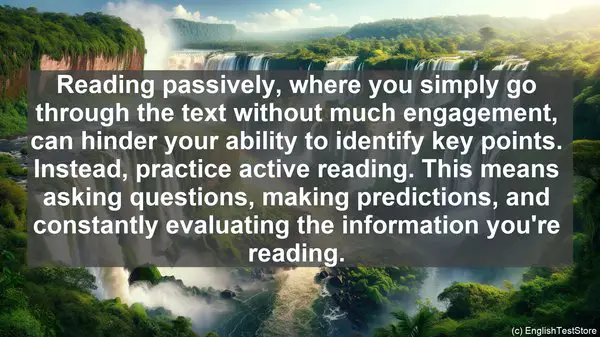Introduction: The Importance of Identifying Key Points
Welcome to today’s lesson. When it comes to the TOEFL iBT reading section, one of the most crucial skills to have is the ability to identify key points. These key points act as the backbone of the text, and understanding them is essential for comprehending the overall meaning. In this video, I’ll be sharing 10 strategies that will make this task easier for you. So, let’s dive in!

1. Skim the Text First
Before delving into the details, it’s always a good idea to skim through the text. This gives you a general idea of what the passage is about and helps you identify the main topic. Pay attention to headings, subheadings, and the opening and closing paragraphs. These sections often contain important information that sets the context.
2. Highlight Keywords and Phrases
As you read, make it a habit to highlight or underline keywords and phrases. These are often the key points or ideas the author is trying to convey. By visually marking them, you create a visual map of the text, making it easier to refer back to them later.
3. Pay Attention to Repetition
Authors often repeat certain words or phrases throughout the text. This repetition serves as a clue that the information is important. So, if you come across a term that’s repeated multiple times, make a note of it. Chances are, it’s a key point.
4. Look for Transitional Words and Phrases
Transitional words and phrases, such as ‘however,’ ‘therefore,’ or ‘in contrast,’ are like signposts in a text. They indicate a shift in the author’s argument or the introduction of a new idea. By identifying these transitions, you can pinpoint the key points that follow.
5. Analyze the Structure
The structure of a passage can often give you insights into its key points. For example, if you’re reading a cause-and-effect passage, the author’s main points will likely revolve around the causes and their effects. By understanding the structure, you can anticipate what the key points might be.

6. Summarize Each Paragraph
After reading a paragraph, take a moment to summarize its main idea in your own words. This exercise not only helps you consolidate your understanding but also ensures that you’re identifying the key points correctly. If your summary aligns with the author’s intent, you’re on the right track.
7. Look for Supporting Evidence
Key points are often supported by evidence or examples. So, as you read, be on the lookout for these supporting details. They not only reinforce the main idea but also provide additional context and depth.
8. Consider the Author’s Tone
The author’s tone, whether it’s objective, subjective, or persuasive, can give you clues about the key points. For example, if the author is using strong language or making a passionate argument, that’s likely a key point they want to emphasize.
9. Practice Active Reading
Reading passively, where you simply go through the text without much engagement, can hinder your ability to identify key points. Instead, practice active reading. This means asking questions, making predictions, and constantly evaluating the information you’re reading.
10. Review and Reflect
Once you’ve finished reading a passage, take some time to review and reflect on what you’ve learned. Ask yourself questions like, ‘What were the main points?’ or ‘How did the author support their arguments?’ This post-reading analysis not only reinforces your understanding but also helps you internalize the key points.
